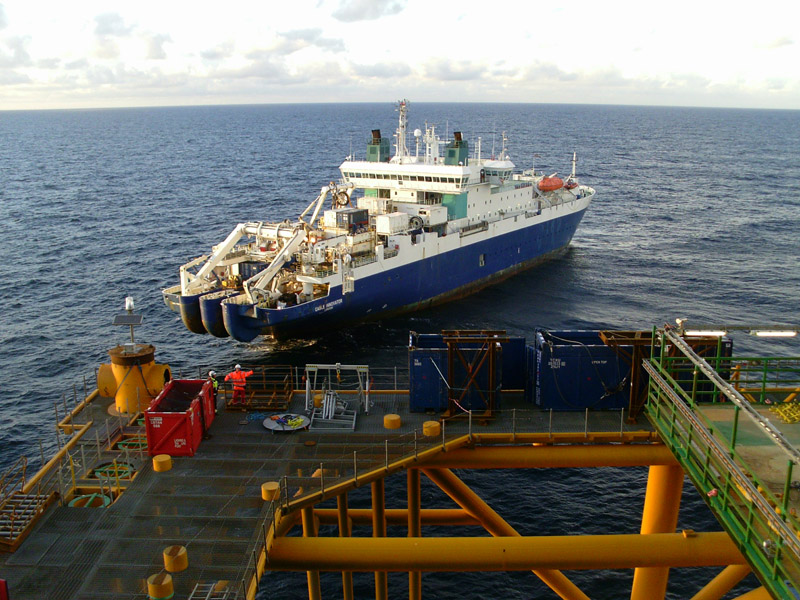August Editorial Focus - Global Marine Systems Limited
The Platform Challenge
Andrew Lloyd, Director, Installations at Global Marine Systems Limited describes the process of connecting oil and gas platforms with fiber optic telecommunications cables and how to overcome the specific and sometimes considerable challenges that lie in wait.

Cable Innovator supporting J-tube pull in operations in the North Sea.
Regardless of whether the requirement is platform-to-platform or platform-to-shore connections, installing subsea fiber optic telecommunication cables begins with the same process—a DTS (desktop study) that forms the foundation for the FEED (front end engineering design) study—and we use our in-house engineering teams and GeoCable GIS (geographical information system) software. This intelligent software helps manage and analyze geographically referenced data, giving quick access to over 2 million kilometers of as-laid cable data, along with the locations of pipelines, subsea structures, fishing grounds, and even must-avoid locations such as munitions dumps. It’s one of the largest databases of its kind in the world.
Properly executed, the study should detail all the influences on cable route safety and provide sound engineering solutions for the environment encountered. It should also specify the quantity of submarine cable and the plant required to build the system.
The study provides a technical reference for the entire project and throughout the life of the cable system, detailing factors likely to influence all subsequent activities, from survey through installation, and then throughout the system’s operations and maintenance lifecycle. It’s an extremely meticulous, but essential part of all oil and gas projects and can take around 2 months to execute to provide the necessary level of detail.
Ultimately, the study will recommend a route that does not conflict with existing subsea infrastructure. It will also provide recommendations for cable type, armor type, and any other engineering challenges such as burial requirements and cable crossing points.
With the study complete, the proposed route is then subject to a dedicated marine hydrographic survey. A survey vessel will sail the route to determine the exact nature and topology of the seabed. Here, geophysical survey tools will include echo-sounders, sonar, sub-bottom profilers, and magnetometers that, in combination with geotechnical sampling, provide a comprehensive set of data that is charted and incorporated into the GIS software, updating the route where required.
The survey data are also interpreted and used to perform burial assessments that, when combined with knowledge gained from the DTS study, help determine the best burial tools and cable protection measures for the system. Based on a typical cable length of 30 to 50 km for an oil/gas project, a marine survey can take around 3 months to complete, including all the reporting and charting.
Both during and after the marine survey, we are able to use the data collected to optimize the cable route and create key engineering documents that form the cable installation blueprint. Comprehensive route position lists (RPLs) and straight line diagrams (SLDs) will be generated that detail the position and all aspects of the cable route such as the cable plant (branching units, repeaters, joints, beach manholes), cable lengths, armor types, transitions, slack, water depths, cable and pipeline crossing points, and maritime boundaries.
The drafting of operational procedures will also start answering questions: How will the cable be handled? How will it be deployed over the stern? How will it be buried? How will it be pulled onto and terminated on the platform itself?
Alongside this, a procedure will be drawn up detailing how our vessel will enter the platform’s 500-m zone and how people will get on and off the platform, which will all be agreed upon with the platform owners. All of the documents and drawings we produce are presented to the platform owners and end customer for sign-off.
Permitting is another challenge. Our permitting department is responsible for obtaining and assisting with any consents, licenses, permits, or other permissions required. Such permits are subject to an array of regulatory requirements, particular to each country, which can be complicated by international, national, and local legislation.
Only when permitting is complete can the installation vessel be mobilized. Here, specialist equipment will be loaded and the cable installation team will join the vessel, first sailing to the port of cable manufacture before heading to the work site.
Firstly, grapnels are pulled along the seabed to ensure the route is clear of debris. It’s surprising what can obstruct a route—aside from the usual abandoned rope and netting—we’ve encountered downed helicopters, sea containers, and even cars that have fallen off transporter vessels.
The cable is then laid, typically to a tolerance of ±1 m, along with any other cable plant such as branching units or CEM (cable end modules)—a CEM allows subsea rather than on-platform cable termination, a trend we are witnessing increasingly. Where possible, we simultaneously lay and bury the cable through a subsea plough to ensure the cable is immediately protected and deploy additional protection at cable or pipeline crossings. If the cable does have to be terminated onto a platform, then the engineering documents produced at the start of the project will be used to ensure the cable can be safely pulled on the platform and routed to the termination location.
A typical project, including cable loading, installation, and reporting will take approximately 60 days, depending on weather delays, which arguably presents one of our biggest challenges, particularly in the North Sea where weather conditions can change very quickly. Once complete, the cable is fully function tested and final reports are prepared for customer sign-off. Job done!

